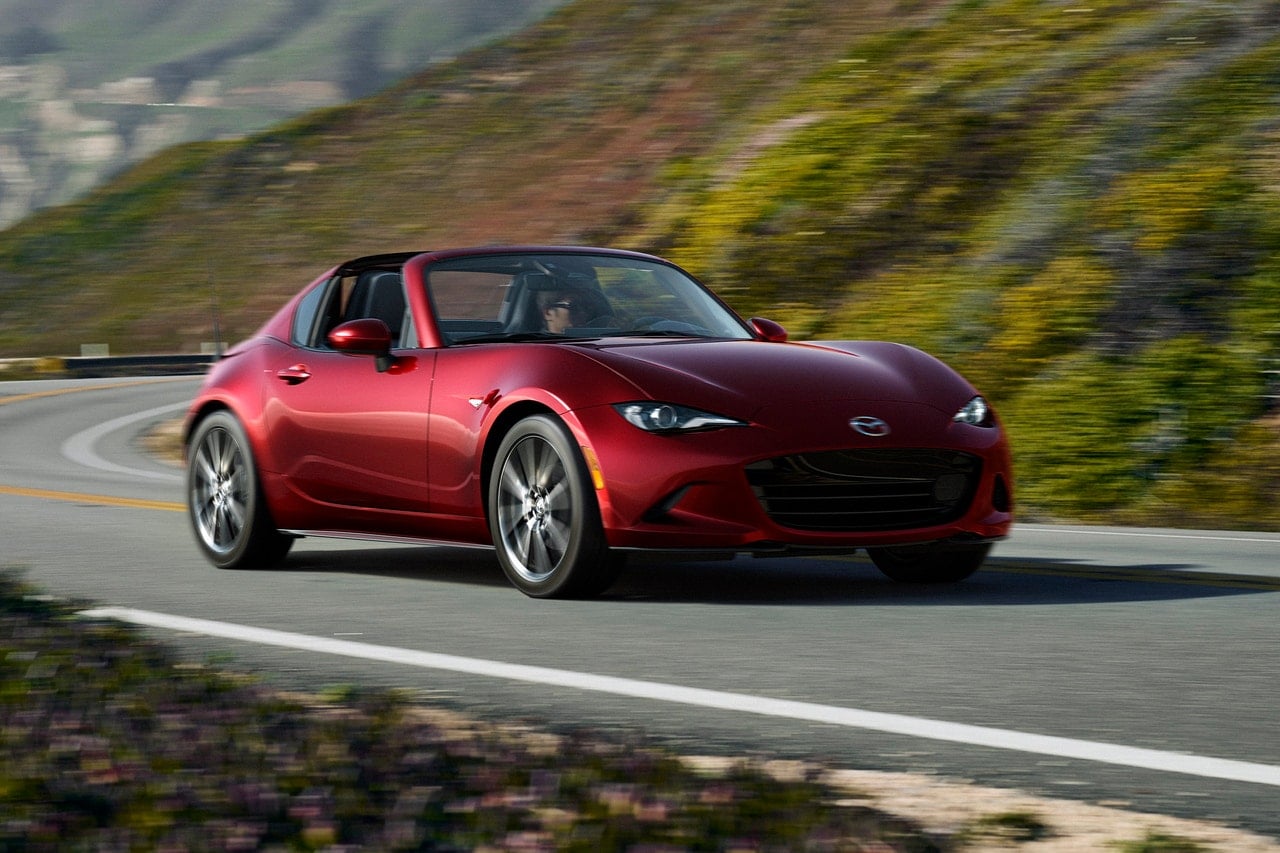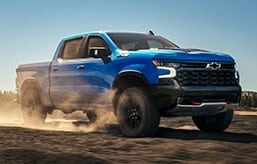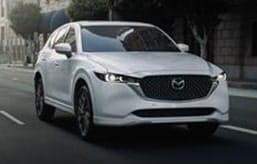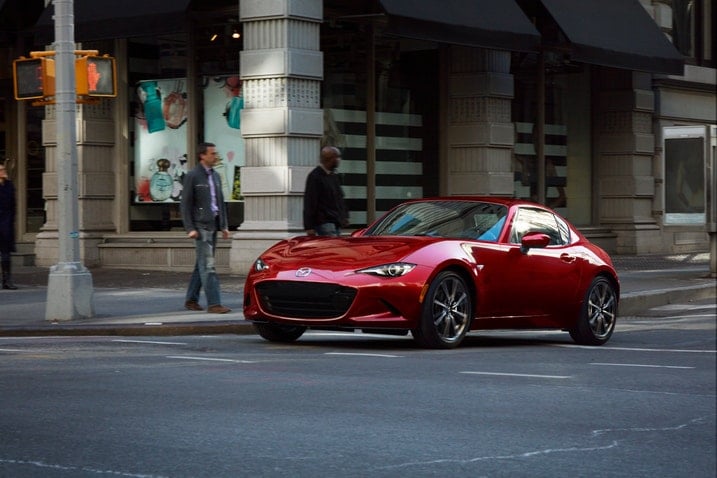- Mazda's Miata is a lesson in avoiding car bloat.
- Miata engineer Dave Coleman says building cars is about “the balance between giving people enough of what they think they want without spoiling the whole package.”
- Still “there are some very good reasons for cars getting bigger and heavier,” Coleman says.
Mazda's Miata Can Teach SUVs a Thing or Two
The Miata is the anti-SUV. Does the little roadster have anything to offer mainstream transportation?
There isn’t a lot I can say about the Mazda Miata that hasn’t already been said. For enthusiasts, the Miata has always been the answer to the question of the sporty, affordable roadster. Today, the little roadster shows remarkable clarity of vision. It is just 99 pounds heavier than the NA Miata that debuted at the Chicago Auto Show in February 1989. It is cheap, light on features, and enormously fun to drive. Getting behind the wheel of a Miata is like those little citrus candies fancy restaurants give you before dessert — it's a genuine palette cleanser in the best way.
That clarity of vision and focus just isn’t present in larger, more pedestrian cars. While the Miata has remained a tiny car for its entire 30-plus-year lifespan, everything around it has ballooned in size. Would you belive that the current Honda Accord is the same size as a BMW 5 Series from just 20 years ago? Their wheelbases are now identical at 111.4 inches apiece. Automakers tailor their cars to legislative and consumer demand to move products, and often, that leads to quite a lot of bloat. This bloat often leads to one major problem: the physical real estate a vehicle occupies.
Where does this trend end? Does it all stop when everything's the size of a Hummer? To find out if there’s a way out of this unsustainable model, I sat down with Dave Coleman, vehicle development engineer at Mazda. Dave is the man to talk to about Miatas. Brought in at the end of the previous NC-generation Miata, Coleman is a car guy’s car guy. He grew up ogling his dad’s RX-7 and now owns several Miatas; one is a Hayabusa-powered racer. Coleman played a large part in the ND development and spent the project's early days driving an NC mule with test panels on it.
Let’s clarify real quick. The constant cycle of updating, adding tech, and piling in more seats and features to sell cars is unsustainable because heavier, larger vehicles exist in a world that does not grow with them. Your new 2023 Toyota 4Runner, measuring 75.8 inches wide, still has to drive on roads and park in spots that were built well before the 4Runner was even a glimmer in Toyota's eye. That SUV’s third model generation was just 66.5 inches wide, and while it wasn't a small car in its day, now it looks positively puny compared to the leviathans that endlessly patrol our roads. You’d feel like you didn’t fit in the same places if nearly 10 inches showed up on your waist over two decades too.
Even the tiny Miata can suffer from it. Coleman is the first to admit the NC Mazda Miata was beginning to slip away from the consistency the car is known for. “The NC is a big, heavy car only in a world of Miatas. When we were making it, internally, we were all kind of distressed over how heavy it was, but it was still the lightest car on the market.” The engineer attributes this to one of several reasons cars grow in the modern age: platform sharing.
“That car, you know, had to share a lot of hardpoints with RX-8.” The RX-7 successor, now arguably on the cusp of ironic-cool among enthusiasts, wasn’t very well received initially. As Coleman points out, Mazda needed the two to make financial sense, and having two sports cars on two platforms is so expensive only Porsche can pull it off. (And even then, the original Boxster was a 911 chassis with some heavy modifications.) In the absence of a singular, focused platform to play with, engineers and designers are left to work within several other constraints. Coleman tells us that consumer feedback is also considered when it’s time to update a car. It is also part of the problem.
“Everybody always says they want more.” Of course, he says, people don’t take into account that “more” has side effects. If you want a quieter car, it has to be heavier. If you want a faster one, it has to be lighter or more powerful. There is always a give and take, and Coleman directly attributes this constant need for more to the automotive bloat of the last 20 years. (The 4Runner is far from the only car that's ballooned in size.) “We have to always kind of find the balance between giving people enough of what they think they want without spoiling the whole package.”
The question then becomes: “What’s next?” How do we make the Miata of SUVs? Something that strikes the balance without becoming distended, massive and wasteful? And how do automakers make that idea sell? Part of it, certainly, is a shift in cultural ideas we haven’t seen yet. Americans like big cars. According to JD Power, 80% of new car purchases are trucks and SUVs.
For Mazda, the solution, for now, is to be as minimal as you can while catering to this demand. Take the CX-50 and the CX-90, both new vehicles from the brand. They’re within tenths of an inch of their competitors' dimensions but offer a significantly nicer interior that’s focused on being distraction-free. It’s likely Mazda’s cars won’t continue to grow beyond their current size, either. Mazda is a much smaller company, and as such Coleman says that there is a pressure to stay small so that models sold here also fit into smaller markets (and parking spaces) in places like Europe and Japan.
Without size and flashy features, as Coleman put it, moving cars at Mazda is about putting butts in seats. Mazda’s argument for its larger cars, much like the Miata, is that it offers buyers a car that provides comfort and confidence while striking a balance with tech, luxury and features. Coleman wants you to feel “at ease and confident controlling the car.”
The brand’s buzzword for this is “Jinba Ittai,” or the oneness of horse and rider. Essentially, it means that your inputs on the car have weight and value that inspire confidence and cohesion with the car. The engineer acknowledges the biggest problem with that is that it can’t be shown to someone in an ad the way a new feature can be.
Even Mazda’s own marketing reflects this idea. Take its ad campaign with actor Hiroyuki Sanada. The TV spots emphasize these ideals. Sanada’s voice goads you with the question “What happens when you build a car around its driver?” Ask Mazda, and the answer is good things topped with less-is-more ideals.
But not all bloat in cars is bad. Safety has come a long way, and in the event of an accident you'd probably want to be in something a lot newer than a 1997 4Runner. “There are some very good reasons for cars getting bigger and heavier,” Coleman confesses. But the Miata is safer than ever too. While not tested by the IIHS or the NHTSA, the car has a four-star crash safety rating (out of five stars) in Europe’s New Car Assessment Program testing. Coleman says nothing works quite like a nice, big crumple space to enhance safety, but the Miata shows that clever engineering and packaging are darn good replacements for one.
Coleman and Mazda say that the best way is to build out from the driver’s seat. “Their [the customer] experience starts with what position you’re physically in, as you’re riding this moving car … putting the customer’s experience first in the car and building out from there helps protect you against irrational growth of the vehicle.”
The little car’s less-is-more philosophy is certainly something the industry can learn from. “If we stick to that philosophy of starting from the benefit that the people in the car get from being in that car, then whatever growth in the vehicle size and weight we have will be tempered by some sort of base and logic.”






 by
by